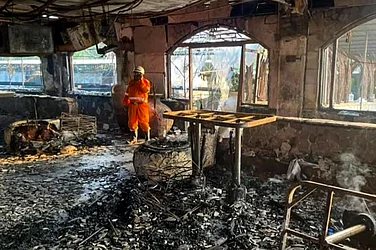A mixture of adverse weather and farm fires in Punjab on Saturday drove Delhi's air quality to close to severe category.
A layer of pungent haze lingered over Delhi on Saturday morning amid low temperatures, calm wind, and an increase in incidents of stubble burning in Punjab.
The overall Air Quality Index (AQI) of Delhi stood at 396 at 10 am, worsening from 357 at 4 pm on Friday. It was 354 on Thursday, 271 on Wednesday, 302 on Tuesday, and 312 on Monday (Diwali).
Anand Vihar with AQI of 454 was the most polluted place in Delhi, followed by Wazirpur (439), Narela (423), Ashok Vihar (428), Vivek Vihar (427), and Jahangirpuri (438), all of whom recorded "severe" air quality.
The air quality in the neighbouring cities of Ghaziabad (381), Noida (392), Greater Noida (398), Gurugram (360) and Faridabad (391) also inched closer to the "severe" category.
An AQI between zero and 50 is considered "good", 51-100 "satisfactory", 101-200 "moderate", 201-300 "poor", 301-400 "very poor", and 401-500 "severe".
According to the Central Pollution Control Board (CPCB), the concentration of lung-damaging fine particles known as PM2.5 was above 400 micrograms per cubic metre at 10 am, around seven times the safe limit of 60 micrograms per cubic metre, in many areas.
The India Meteorological Department (IMD) said calm winds prevailed at night, adding that moderate wind speed (up to 8 kmph) is predicted during the day.
In cold conditions, pollutants are trapped close to the ground because of low mixing height — the vertical height in which pollutants are suspended in the air.
SAFAR, a forecasting agency under the Union Ministry of Earth Sciences, predicted that the share of stubble burning in Delhi's pollution is likely to increase in the coming days.
The contribution of stubble burning to Delhi's PM2.5 pollution has so far remained low (up to 7 per cent) due to a prolonged rain spell in early October and slow transport-level winds which were not strong enough to carry smoke from farm fires to Delhi.
Farmers in Punjab burn stubble every year, which becomes a leading environmental hazard in Delhi and North India every year. The Indian Agricultural Research Institute (IARI) reported 2,067 farm fires in Punjab on Friday, the highest so far this season. It logged 124 and 34 cases of stubble burning in Haryana and Uttar Pradesh, respectively, on Friday.
Along with unfavourable meteorological conditions, paddy straw burning in adjoining states is a major reason behind the alarming spike in air pollution levels in the national capital in October and November. Farmers set their fields on fire to quickly clear off the crop residue before cultivating wheat and vegetables.
As per the IARI, Punjab reported 71,304 farm fires between September 15 and November 30 last year and 83,002 farm fires in the corresponding period in 2020.
Last year, the share of farm fires in Delhi's PM 2.5 pollution peaked to 48 per cent on November 7.
(With PTI inputs)


























